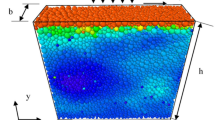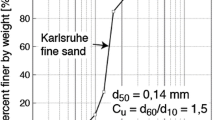Abstract
This paper utilizes the Discrete Element Method to characterize energy dissipation mechanisms in cyclically loaded soils based on micromechanical considerations. Computational simulations of consolidated undrained cyclic triaxial tests were conducted at various relative densities and were subjected to cyclic loading of different frequencies and shear strain amplitudes. The different components of microscale energies were monitored during the course of the simulations and characterized into input and dissipated energies. A comparison is made between the dissipated energy computed from microscopic energy components and macroscopic energy calculated based on the area of the deviator stress-axial strain loops. These energies are then used to obtain the specific damping capacity defined as the ratio of dissipated energy during one cycle to the maximum stored elastic energy during the same cycle. The conducted simulations highlight the importance of calculating actual stored energy in the system as opposed to approximating it to be that calculated as the triangular area under the secant modulus. Finally, a series of simulations that resulted in liquefaction are discussed, and the amount of energy dissipated to liquefaction is examined based on these results.



















Similar content being viewed by others
References
Asmar B, Langston P, Matchett A, Walters J (2003) Energy monitoring in distinct element models of particle systems. Adv Powder Technol 14(1):43–69
Assimaki D, Kausel E, Whittle A (2000) Model for dynamic shear modulus and damping for granular soils. J Geotech Geoenviron Eng ASCE 126(10):859–869
ASTM (1991) Standard D 3999-91: Test method for the determination of the modulus and damping properties of soils using the cyclic triaxial apparatus. Annual Book of ASTM Standards, ASTM International, West Conshohocken
Boulanger R (2003) High overburden stress effects in liquefaction analyses. J Geotech Geoenviron Eng ASCE 129(12):1071–1082
Boulanger R, Idriss I (2006) Liquefaction susceptibility criteria for silts and clays. J Geotech Geoenviron Eng ASCE 132(11):1413–1426
Brennan AJ, Thusyanthan NI, Madabhushi SPG (2005) Evaluation of shear modulus and damping in dynamic centrifuge tests. J Geotech Geoenviron Eng 131(12):1488–1497
Cundall P, Strack O (1979) A discrete numerical model for granular assemblies. Geotechnique 29(1):47–65
Davis R, Berrill J (1982) Energy dissipation and seismic liquefaction in sands. Earthq Eng Struct Dyn 10:59–68
Denissen C (2009) A micromechanical study of energy dissipation mechanisms in granular soils subjected to cyclic loading. Master thesis, Southern Methodist University, Dallas
Di Renzo A, Di Maio F (2004) Comparison of contact-force models for the simulation of collisions in dem-based granular flow codes. Chem Eng Sci 59:525–541
Dobry R, Ladd R, Yokel F, Chung R, Powell D (1982) Prediction of pore water pressure buildup and liquefaction of sands during earthquakes by the cyclic strain method. Building Science Series, National Bureau of Standards, U.S. Department of Commerce 138, 154
Dobry R, Ng T (1992) Discrete modeling of stress-strain behavior of granular media at small and large strains. Eng Comput 9:129–143
Edwards S (1998) The equations of stress in a granular material. Phys A 249:226–231
El Shamy U, Aydin F (2008) Multi-scale modeling of flood-induced piping in river levees. J Geotech Geoenviron Eng ASCE 134(9):1385–1398
El Shamy U, Zeghal M (2005) A coupled continuum-discrete model for saturated granular soils. J Eng Mech ASCE 131(4):413–426
El Shamy U, Zeghal M (2005b) A micro-mechanical study of the seismic response of saturated cemented deposits. J Earthq Eng 9:47–75. (Special Issue 1 on Geotechnical Earthquake Engineering)
Figueroa J (1990) A method for evaluating soil liquefaction by energy principles. Proceedings of 4th U.S. National Conference on Earthquake Engineering, Earthquake Engineering Research Institute, El Cerrito
Figueroa J, Saada A, Liang L, Dahisaria M (1994) Evaluation of soil liquefaction by energy principles. J Geotech Eng ASCE 120(9):1554–1569
Hardin B, Drnevich V (1972) Shear modulus and damping in soils: design equations and curves. J Soil Mech Found Div ASCE 98(7):667–692
Hashash Y, Park D (2002) Viscous damping formulations and high frequency motion propagation in non-linear site response analysis. Soil Dyn Earthq Eng 22:611–624
Itasca (2005) Particle Flow Code, PFC3D, release 3.1. Itasca Consulting Group, Inc., Minneapolis
Kramer S (1996) Geotechnical earthquake engineering. Prentice Hall, New Jersey
Lai C, Rix G (1998) Simultaneous inversion of rayleigh phase velocity and attenuation for near-surface site characterization. Report No. GIT-CEE/GEO-98-2, Georgia Institute of Technology
Law K, Cao Y (1990) An energy approach for assessing seismic liquefaction potential. Can Geotech J 27:320–329
Lazan B (1968) Damping of materials and members in structural mechanics, 1 edition. Pergamon Press, Great Britain
Lee G, Hartmann B (1998) Specific damping capactiy for arbitrary loss angle. J Sound Vib 211(2):265–272
Liang L, Figueroa J, Saada A (1995) Liquefaction under random loading: unit energy approach. J Geotech Eng ASCE 121(11):776–781
Nashif A, Jones D, Henderson J (1985) Vibration damping. Wiley, New York
Nemat-Nasser S, Shokooh A (1979) A unified approach to densification and liquefaction of cohesionless sand in cyclic shearing. Can Geotech J Nat Res Counc Can 16:659–678
Ng T, Dobry R (1994) Numerical simulations of monotonic and cyclic loading of granular soil. J Geotech Eng ASCE 120(2):388–403
Rajamani R, Mishra B, Venugopal R, Datta A (2000) Discrete element analysis of tumbling mills. Powder Technol 109:105–112
Read B, Dean G (1978) The determination of dynamic properties of polymers and composites. Wiley, New York
Richart FJ, Woods R, Hall JJ (1970) Vibration of soils and foundations. Prentice Hall, Englewood Cliffs, NJ. Civil engineering and engineering mechanics series
Schnabel P, Lysmer J, Seed H (1972) Shake: a computer program for earthquake response analysis of horizontally layered sites. Report No. EERC 72-12, Earthquake Engineering Research Center, University of California, Berkeley
Seed H, Idriss I (1971) Simplified procedure for evaluating soil liquefaction potential. J Soil Mech Found Div ASCE 97(9):1249–1274
Seed H, Wong R, Idriss I, Tokimatsu K (1986) Moduli and damping factors for dynamic analyses of cohesionless soils. J Soil Mech Found Div ASCE 112(11):1016–1032
Sitharam TG, Vinod JS (2010) Evaluation of shear modulus and damping ratio of granular materials using discrete element approach. Geotech Geol Eng 28:591–601
Thevanayagam S, Kanagalingam T, Shenthan T (2003) Intergrain friction, contact density, and cyclic resistance of sands. Proc. of 2003 Pacific Conference on Earthquake Engineering, Christchurch, New Zealand
Thornton C (2000) Numerical simulations of deviator shear deformation of granular media. Geotechnique 50(1):43–53
Tsuji Y, Kawaguchi T, Tanaka T (1993) Discrete particle simulation of two-dimensional fluidized bed. Powder Technol 77:79–87
Vucetic M, Dobry R (1991) Effect of soil plasticity on cyclic response. J Soil Mech Found Div ASCE 117(1):89–107
Author information
Authors and Affiliations
Corresponding author
Rights and permissions
About this article
Cite this article
El Shamy, U., Denissen, C. Microscale Energy Dissipation Mechanisms in Cyclically-Loaded Granular Soils. Geotech Geol Eng 30, 343–361 (2012). https://doi.org/10.1007/s10706-011-9472-3
Received:
Accepted:
Published:
Issue Date:
DOI: https://doi.org/10.1007/s10706-011-9472-3




